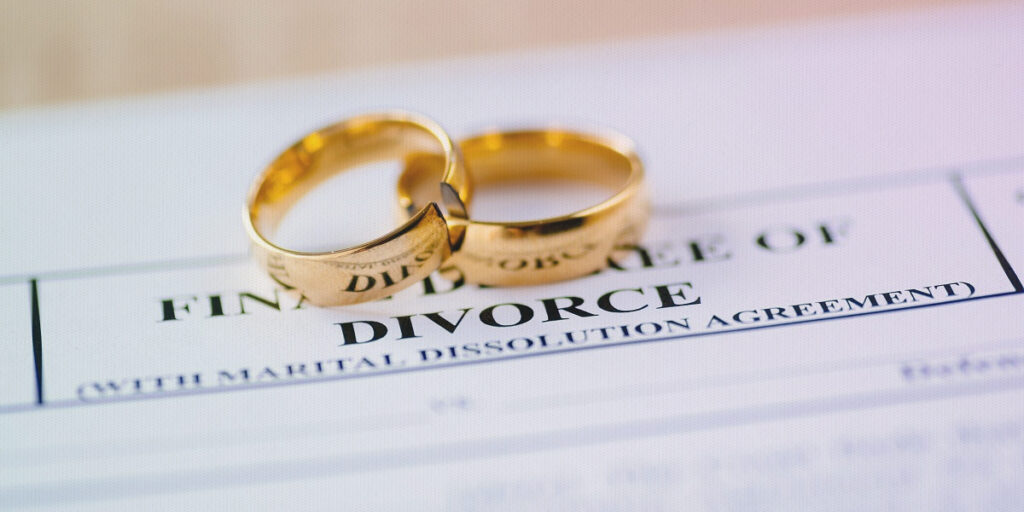
Conditional residents that obtained a two-year green card through marriage will typically file a joint petition using Form I-751, Petition to Remove Conditions on Residence, within the 90-day period before it expires. The conditional resident normally files jointly with the spouse. Once approved, U.S. Citizenship and Immigration Services (USCIS) grants the conditional resident status as a lawful permanent resident and provides a 10-year green card. But what if the conditional resident gets a divorce or annulment before the two-year period ends? Or what happens if the spouse is abusive and refuses to file the joint petition? The I-751 waiver after divorce provides a solution to this difficult situation.
USCIS will allow a conditional resident to remove conditions on residence after divorce or other events that make it impossible to file a joint petition with the spouse through whom he or she gained conditional residence. In these cases, the conditional resident must file the petition with a request that the joint filing requirement be waived, commonly known as a waiver. The conditional resident can still become a lawful permanent resident, but it’s not a simple matter. The stakes are high. USCIS will more closely scrutinize the I-751 petition. And an unsuccessful petition may result in removal proceedings for the conditional resident.
I-751 Waiver Also Requires a Good Faith Marriage
If a marriage has been terminated due to death or divorce, and even if the spouse has abused the conditional resident, there’s still an important requirement to prove it started as a good faith marriage. The I-751 waiver after divorce is not a free pass; you’ll need to prove your intentions were honest when you entered the marriage.
USCIS wants to verify that the you entered the marriage for love, not for a green card. A good faith marriage is one that is built on love and starts with the genuine desire to build a life together. A fraud or sham marriage is when an individual enters into the marriage for the purpose of going around immigration laws to falsely acquire immigration benefits.
USCIS can’t know what happens inside the privacy of a couple’s home. Therefore, USCIS needs the petitioner to prove his or her own good faith marriage by presenting evidence. Anyone attempting to file to remove the conditions on residence with a waiver after divorce needs to understand that there is still an important requirement to prove a good faith marriage. Wedding records, birth certificates of children, and joint financial records are examples of documents that can be used to prove a good faith marriage.
RECOMMENDED: 33 Great Documents for Proving a Bona Fide Marriage on an I-751 Petition
Waiver Creates Additional Burdens of Proof
By not filing jointly with the spouse through whom conditional residence was gained, a petition automatically raises red flags. There is a burden of proof for the single petitioner to prove that he or she originally entered the marriage in good faith and the marriage cannot continue through no fault of the petitioner.
As you may notice when reviewing Form I-751, there are multiple options for filing with a waiver to the joint filing requirement. And multiple choices may apply to your situation. But the option selected and the strategy for proceeding may have benefits and drawbacks. Discuss it with an experienced immigration attorney. The options that may (or may not) apply to this situation include:
- Option A: I entered the marriage in good faith, but the marriage was terminated through divorce or annulment.
- Option B: I entered the marriage in good faith, and, during the marriage, I was battered, or was the subject of extreme cruelty, by my U.S. citizen or permanent resident spouse.
- Option C: The termination of my status and removal from the United States would result in an extreme hardship.
How to File an I-751 Waiver after Divorce
To file Form I-751 with a waiver to the joint filing requirement, the following items should be included in the package:
- USCIS filing fee (as listed at USCIS)
- A copy of both sides of your permanent resident card
- A copy of the divorce decree or annulment document that ended your marriage. (If not available, include evidence that the divorce proceedings have started.)
- Evidence of a “good faith” marriage. See 33 Great Documents for Proving a Bona Fide Marriage on an I-751 Petition
- Evidence regarding the circumstances surrounding the end of your marriage (see below)
Other Evidence
A personal statement and evidence describing the circumstances of your divorce or pending divorce can also be helpful for the I-751 waiver.
- No-Fault Divorce: If your divorce was due to irreconcilable differences or a mutual decision to terminate the marriage, you can explain that the divorce was a no-fault action and the differences that led to the end of your marriage. Examples of irreconcilable differences can include: disagreements about whether to have children, where to live, or anything else that is relevant. If you attempted to save the marriage through marriage counseling, you can include records (e.g. invoices) or proof that you attempted to get counseling.
- Divorce by Fault of Ex-Spouse: In some cases a divorce is forced by actions of a spouse. The divorce may be the result of the spouse’s actions such as adultery, abandonment, impotency, or imprisonment. In these cases, you can submit a copy of the divorce or annulment petition that alleged those fault grounds or other evidence that supports the claims.
Any statement made that suggests you were “at fault” in the divorce can have a negative effect on your case. If you believe the divorce was the result on your actions (e.g. adultery, abandonment, etc.), it’s even more important to seek advice from an experienced immigration attorney.
When filing Form I-751 jointly with a spouse, the petition must be filed within the 90-day period before the conditional resident’s green card expires. When filing with a waiver after divorce, the petition can be filed any time after conditional resident status is granted and before the conditional resident is removed.
Waiver When the Divorce is not Final
In some cases the conditional resident’s status may expire before a divorce is final. Divorce proceedings can be very lengthy and interfere with the expiration date of conditional residency. In these cases, there are multiple options which include (but are not be limited to):
- File I-751 with evidence that you have initiated the divorce proceedings (and perhaps copies of scheduled court dates related to the divorce)
- Wait to file I-751 until conditional resident status has expired and you are placed into removal proceedings
In these cases the conditional resident should always consult with an experienced immigration attorney that can provide advice on the best strategy for the petitioner.

If the conditional resident chooses to file Form I-751 with a waiver based on divorce, USCIS will want proof that the marriage has been terminated (e.g. divorce decree or annulment) before it is granted. Therefore, it is helpful to your case to provide evidence that the divorce has been initiated. Examples of acceptable evidence include the court documents that demonstrate the case is in process. In most cases, USCIS will mail a receipt notice (Form I-797C) that extends the conditional resident’s green card for an additional period of time (usually one year). USCIS will also issue a “Request for Evidence” at a later date that asks for the final divorce decree when available.
Waiver without a Divorce – Extreme Hardship
It is possible to file an I-751 waiver even if the spouse refuses to a divorce or the couple is separated and a legal divorce was never filed with the court. If the conditional resident can demonstrate “extreme hardship,” he/she may be eligible to file the I-751 on this ground. Establishing an extreme hardship case can be very difficult. For this reason, the petitioner should always obtain the assistance of an experienced immigration attorney.
Extreme Hardship Defined
An extreme hardship can be difficult to define. USCIS has made clear that the hardship must have arisen after the petitioner received conditional residence. Beyond that, there are not specifically defined requirements for an extreme hardship. An attorney can help you with this process. USCIS may consider the following factors in an extreme hardship case:
- Age of the conditional resident
- If the conditional resident has children, the age, number, and immigration status of the children and their ability to speak the language or adjust to life in another country
- Health of the conditional resident and/or health of the conditional resident’s child, spouse, or parent
- The conditional resident’s ability to earn income and find a job in the country to which he/she would return
- Conditional resident’s length of residence in the U.S.
- Conditional resident’s family ties in the U.S.
- Financial impact of the conditional resident’s departure
- Impact of a disruption of educational opportunities
- Psychological impact of the conditional resident’s removal
- Current political and economic conditions in the country that the person would return
- Family and other ties in the conditional resident’s country
- Conditional resident’s contributions to and ties to the U.S.
- Conditional resident’s immigration history
Interview

After filing Form I-751 with a waiver, the petitioner should expect to attend an interview at the local district office where the conditional resident lives. Petitions with waivers are decided on a case-by-case status. So every detail counts.
This is not a complete description of evidence that must be submitted with Form I-751. Filing an I-751 waiver after divorce or other events can be a complex process that requires expert knowledge of the law. For these reasons, individuals should consult with an experienced immigration attorney before filing the I-751 waiver after divorce. Refer to USCIS or utilize the services of CitizenPath for a thorough list of items which must be submitted with the petition.
About CitizenPath
CitizenPath provides simple, affordable, step-by-step guidance through USCIS immigration applications. Individuals, attorneys and non-profits use the service on desktop or mobile device to prepare immigration forms accurately, avoiding costly delays. CitizenPath allows users to try the service for free and provides a 100% money-back guarantee that USCIS will approve the application or petition. We provide support for the Petition to Remove Conditions on Residence (Form I-751), Green Card Renewal (Form I-90), the Citizenship Application (Form N-400), and several other USCIS forms.
Note to Reader: This post was originally published on June 5, 2018, and has been modified with improvements.
Want more immigration tips and how-to information for your family?
Sign up for CitizenPath’s FREE immigration newsletter and
SAVE 10%
on our immigration services



